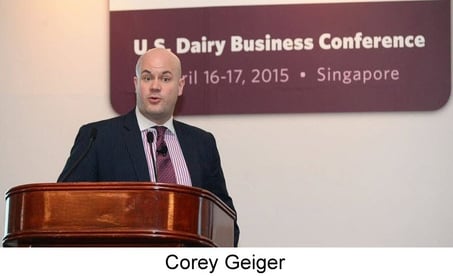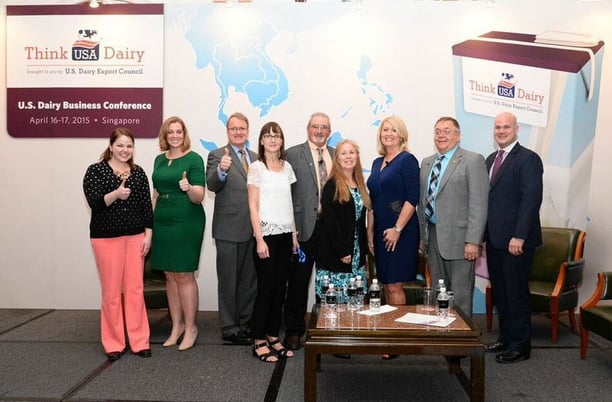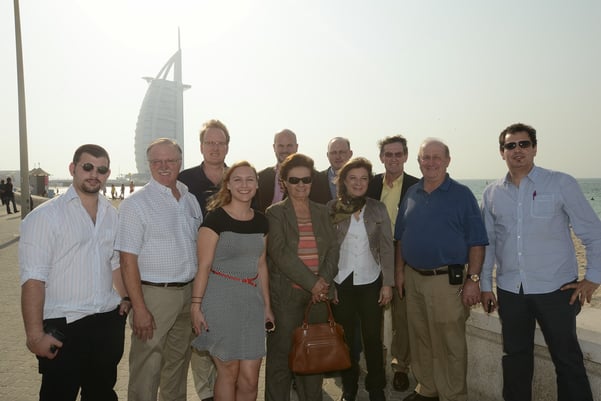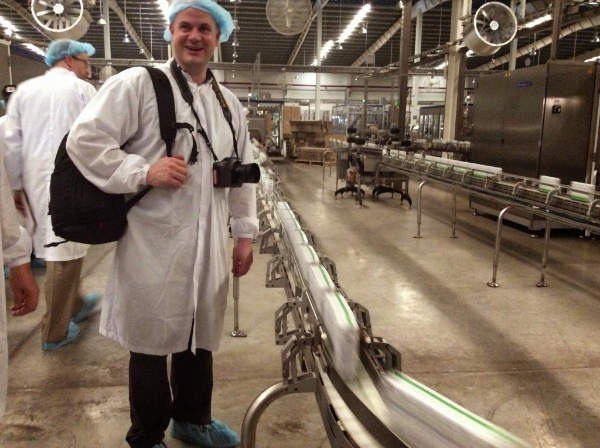-
Editor's Advice to U.S. Dairy Exporters: "Be There"
By USDEC August 6, 2015- Tweet
Corey Geiger says USDEC missions have shown him the importance of building personal, global relationships for the U.S. dairy industry.
 Hoard’s Dairyman managing editor Corey Geiger had just landed at the airport in Ho Chi Minh City, a place most locals still call Saigon, despite the official name change after the Vietnam War.
Hoard’s Dairyman managing editor Corey Geiger had just landed at the airport in Ho Chi Minh City, a place most locals still call Saigon, despite the official name change after the Vietnam War. It was 11 a.m. on a Sunday and the temperature was already 91 degrees, on its way to a high of 95, with tropical humidity.
As Geiger and others on a U.S. Dairy Export Council mission to Southeast Asia waited for a van to take them to the relative comfort of an air-conditioned hotel, John Brubaker, an Idaho dairy farmer, wiped sweat from his brow and said, “This isn’t a place for cows.”
“I agree with you,” said Geiger. “But it is a place for dairy products.”
Vietnam is a top-10 destination by value for U.S. dairy exports and in 2014 Southeast Asia became our second $1 billion market, behind Mexico.
Despite weakened dairy markets worldwide in 2015, there is sufficient evidence to suggest further growth awaits in Southeast Asia.- U.S. suppliers are pursuing the business more aggressively than ever—making the effort needed to be a regional player, including getting their products Halal-certified (a prerequisite in most of Southeast Asia) and tightening ingredient specifications to meet the stringent needs of Southeast Asian food and beverage manufacturers.
- The Organization for Economic Cooperation and Development projects strong 5.4 percent annual economic growth in the region through 2018. And despite recent social unrest in Thailand, regional politics are generally stable, laying a strong economic foundation.
- Domestic and foreign food and beverage firms (i.e., dairy ingredient buyers) continue to invest in capacity, oftentimes building hubs in one Southeast Asian nation to serve the broader geography.
- A U.S. free trade agreement with Singapore helped lift U.S. dairy exports to the nation more than 10-fold since it went into effect in 2004. Now, the United States is getting closer to finalizing free trade deals with Malaysia and Vietnam through the Trans-Pacific Partnership.
- The United States has just begun to tap cheese potential. Foodservice development varies by country but on the whole is fledgling, particularly in Vietnam, which just opened its first McDonald’s last year. In addition, Indonesia and Vietnam are budding producers of processed cheese, requiring rising imports of natural cheese ingredients.
 Geiger, far right, was part of this USDEC mission to Southeast Asia in April.
Geiger, far right, was part of this USDEC mission to Southeast Asia in April.
Geiger, back row, center, was in Dubai with this 2013 USDEC trade mission delegation.
Geiger is aware of and impressed with these facts and figures. But after meeting with overseas dairy customers and consumers on this spring’s USDEC mission trip, as well as making a similar USDEC mission trip to the Middle East in 2013, Geiger sees a vital ingredient to success U.S. exporters would be remiss to overlook.
Geiger sums it up in two words: "Be there."
Not only before the sale, but after it.
“Marketing products is about relationships,” said Geiger, the lead editor for a magazine that is published in English, Spanish and Japanese with copies circulating in over 80 countries. “People want to know the people behind the product and that the product is good. They also want support. It just isn’t a sale for us as we develop these markets in international countries. We need to remember that if something goes awry, our customers want someone they know and have met to contact.”
Geiger said his point is not to minimize other aspects of a successful U.S. dairy export industry, such as having market access or a level competitive playing field, often the result of negotiating free trade agreements.
“If the market access isn’t there, all this is a mute point,” said Geiger. “But once market access is available, having people behind the products makes people believe."
Southeast Asian buyers, as well as buyers in other parts of the world, value ongoing, face-to-face relationships with sellers. It shows commitment on the sellers’ part; it shows that they are in it for the long-haul, he added.
Geiger, part owner of a dairy farm that has been in his family for six generations, saw the impact of a highly personalized approach in the reaction regional dairy buyers had to a presentation four of the mission's dairy farmers made in Singapore during the U.S. Dairy Business Conference.
In a survey, attendees ranked it the best presentation of the conference. One buyer from Indonesia was so persuaded she asked if she could purchase products made exclusively with milk from the farmers who presented a photo slideshow of their farms and families.
“In this era of electronic communications, people still buy from people,” Geiger said.

Geiger wrote that this Vinamilk milk plant in Vietnam is "the world’s most modern."
Other takeaways Geiger had from the Southeast Asia trip include:
- Southeast Asia is already a vital customer, purchasing $1.32 billion in dairy products and ingredients from the U.S. last year―second only to Mexico, which had $1.64 billion in purchases. Third place belonged to China with purchases totaling $697 million.
- Dairy producers, cooperatives and processors can further strengthen the bond with Southeast Asia by doing additional customer service and producing tailor-made products.
- Milk is a valued treasure in Southeast Asia because of its wholesome nutrition. Vietnamese consumers are willing to pay 12 to 15 percent of their monthly income for one can of powdered milk that could nourish a son or daughter for 10 days or fortify the diet of an expectant mother for 10 to 20 days.
Since returning, Geiger has written extensively for Hoard’s Dairyman about U.S. dairy exports, including these stories:
- Southeast Asia employs many U.S. dairy cows
- Protein, protein, protein is trending
- Vietnam, from 91st to 12th in just 20 years
- TPP approval could employ more U.S. cows
- Milk is a valued treasure
- U.S. making inroads in dairy product sales
- The world's most modern fluid milk plant
- Milk in a chewable tablet
Hoard's Dairyman's primary audience is farmers. Geiger said they are keenly interested in exports, even in a year in which their milk prices have fallen.
"I believe dairy farmers are looking at exports as a long-term situation," said Geiger. "There will be ups and downs. But the simple fact is that today every cow in America, one day a week, has her milk goes to an international customer. Exports are important to dairy farmers and this trip reinforced my view that our dairy products are important to international customers.”
Subscribe to the U.S. Dairy Exporter Blog
The U.S. Dairy Export Council is primarily supported by Dairy Management Inc. through the dairy farmer checkoff that builds on collaborative industry partnerships with processors, trading companies and others to build global demand for U.S. dairy products.
10 Most Recent Posts
Most Popular Posts in Past Year
Index of Posts by Topic
- #GotDairyJobs (4)
- About USDEC (65)
- Africa (6)
- Australia (4)
- Blog (8)
- Brazil (4)
- Canada (20)
- Central America (1)
- Cheese (58)
- Chile (1)
- China (54)
- Common food names (7)
- Company News (19)
- Consistent Supply (1)
- Crisis Management (3)
- Cuba (2)
- Dairy (6)
- Dairy checkoff (9)
- Dairy Ingredients (5)
- Dairy Management Inc. (2)
- Dairy Resources (1)
- Dairy Supply Chain (1)
- Dairy Trends (5)
- Documentation (3)
- EU (24)
- Experts on Dairy Exports (4)
- Exporter of the Year (2)
- Exports (24)
- Farmer leaders (1)
- Farming (38)
- Food Aid (8)
- Food Safety (8)
- Foodservice (3)
- Free trade agreements (34)
- Future trends (1)
- Geographical Indications (GIs) (10)
- Global Marketing (86)
- Global Shipping Crisis (1)
- Got Jobs? (9)
- Indonesia (1)
- Innovation (17)
- Japan (17)
- Krysta Harden (1)
- Market Access (25)
- Market Conditions (265)
- Member Services (17)
- Mexico (41)
- Middle East (9)
- Middle East & North Africa (3)
- Middle East/North Africa (9)
- Milk (4)
- Milk Protein Concentrate (MPC) (2)
- New Zealand (11)
- Next5% (20)
- Nonfat Dry Milk/Skim Milk Powder (8)
- Nutrition (18)
- Product Innovation (6)
- Protein (4)
- Regulations (5)
- Research & Data (323)
- Russia (3)
- Singapore (10)
- South America (8)
- South Korea (10)
- Southeast Asia (25)
- Strategic Insights (1)
- Supply (1)
- Sustainability (25)
- Technology (2)
- ThinkUSADairy (5)
- TPM23 (1)
- TPP (13)
- Traceability (8)
- Trade Barriers (5)
- Trade Data (7)
- Trade Policy (72)
- TTIP (5)
- UHT Milk (7)
- USMCA (2)
- Vietnam (4)
- Whey (6)
- Whey Ingredients (2)
- Whey products (10)
- Whole Milk Powder (WMP) (3)
- World Dairy Expo (1)
- World Milk Day (1)
- Yogurt (1)
Index of Posts by Date, Author
- June 2021 (13)
- March 2015 (12)
- September 2015 (12)
- April 2015 (11)
- December 2015 (11)
- March 2014 (10)
- February 2015 (10)
- October 2015 (10)
- October 2014 (9)
- June 2015 (9)
- July 2015 (9)
- November 2015 (9)
- March 2016 (9)
- October 2019 (9)
- September 2013 (8)
- May 2015 (8)
- August 2015 (8)
- January 2016 (8)
- February 2016 (8)
- March 2017 (8)
- December 2018 (8)
- May 2019 (8)
- December 2019 (8)
- June 2014 (7)
- November 2016 (7)
- May 2017 (7)
- May 2018 (7)
- July 2020 (7)
- June 2023 (7)
- July 2016 (6)
- August 2018 (6)
- October 2018 (6)
- November 2018 (6)
- February 2019 (6)
- June 2019 (6)
- August 2019 (6)
- March 2020 (6)
- April 2020 (6)
- June 2020 (6)
- June 2022 (6)
- February 2014 (5)
- June 2016 (5)
- August 2016 (5)
- September 2016 (5)
- December 2016 (5)
- February 2017 (5)
- July 2017 (5)
- October 2017 (5)
- January 2018 (5)
- April 2018 (5)
- June 2018 (5)
- July 2018 (5)
- September 2018 (5)
- January 2019 (5)
- March 2019 (5)
- April 2019 (5)
- July 2019 (5)
- September 2019 (5)
- November 2019 (5)
- January 2020 (5)
- August 2020 (5)
- October 2020 (5)
- April 2021 (5)
- January 2022 (5)
- May 2013 (4)
- September 2014 (4)
- April 2016 (4)
- May 2016 (4)
- October 2016 (4)
- January 2017 (4)
- April 2017 (4)
- June 2017 (4)
- August 2017 (4)
- September 2017 (4)
- December 2017 (4)
- February 2018 (4)
- February 2020 (4)
- May 2020 (4)
- February 2022 (4)
- September 2022 (4)
- April 2023 (4)
- December 2023 (4)
- November 2017 (3)
- March 2018 (3)
- September 2020 (3)
- December 2020 (3)
- February 2021 (3)
- May 2021 (3)
- August 2021 (3)
- December 2021 (3)
- March 2022 (3)
- April 2022 (3)
- May 2022 (3)
- October 2022 (3)
- December 2022 (3)
- May 2023 (3)
- July 2023 (3)
- November 2023 (3)
- March 2011 (2)
- June 2011 (2)
- September 2011 (2)
- March 2012 (2)
- June 2012 (2)
- July 2012 (2)
- March 2013 (2)
- July 2013 (2)
- November 2020 (2)
- January 2021 (2)
- March 2021 (2)
- July 2021 (2)
- September 2021 (2)
- October 2021 (2)
- November 2021 (2)
- July 2022 (2)
- August 2022 (2)
- January 2023 (2)
- March 2023 (2)
- October 2023 (2)
- January 2024 (2)
- February 2024 (2)
- April 2024 (2)
- June 2024 (2)
- July 2024 (2)
- November 2024 (2)
- December 2024 (2)
- February 2025 (2)
- June 2025 (2)
- July 2025 (2)
- January 2010 (1)
- February 2010 (1)
- March 2010 (1)
- April 2010 (1)
- May 2010 (1)
- June 2010 (1)
- July 2010 (1)
- August 2010 (1)
- September 2010 (1)
- October 2010 (1)
- November 2010 (1)
- December 2010 (1)
- January 2011 (1)
- February 2011 (1)
- April 2011 (1)
- May 2011 (1)
- July 2011 (1)
- August 2011 (1)
- October 2011 (1)
- November 2011 (1)
- December 2011 (1)
- January 2012 (1)
- February 2012 (1)
- April 2012 (1)
- August 2012 (1)
- September 2012 (1)
- October 2012 (1)
- November 2012 (1)
- December 2012 (1)
- January 2013 (1)
- February 2013 (1)
- April 2013 (1)
- June 2013 (1)
- August 2013 (1)
- October 2013 (1)
- November 2013 (1)
- December 2013 (1)
- January 2014 (1)
- April 2014 (1)
- May 2014 (1)
- November 2022 (1)
- February 2023 (1)
- August 2023 (1)
- September 2023 (1)
- March 2024 (1)
- May 2024 (1)
- August 2024 (1)
- September 2024 (1)
- October 2024 (1)
- January 2025 (1)
- March 2025 (1)
- April 2025 (1)
- May 2025 (1)
- August 2025 (1)
- USDEC (183)
- USDEC Staff (159)
- Alan Levitt (119)
- Tom Suber (41)
- Margaret Speich (22)
- Marc A.H. Beck (15)
- Vikki Nicholson-West (11)
- Angélique Hollister (11)
- Tom Vilsack (8)
- Jaime Castaneda (7)
- Matt McKnight (7)
- Véronique Lagrange (7)
- Margaret Speich and Mark O'Keefe (7)
- Ross Christieson (7)
- Paul Rogers (6)
- Shawna Morris (5)
- William Loux (5)
- Alan Levitt and Marc Beck (5)
- Krysta Harden (4)
- USDEC Communications (3)
- Kristi Saitama (3)
- Marilyn Hershey (3)
- Brad Gehrke (3)
- Tom Quaife (2)
- Jim Mulhern (2)
- Alan Levitt and William Loux (2)
- Kara McDonald (2)
- Luke Waring (2)
- Merle McNeil (2)
- Andrei Mikhalevsky (1)
- Rodrigo Fernandez (1)
- Nick Gardner (1)
- Dermot Carey (1)
- Jeremy Travis (1)
- Annie Bienvenue (1)
- Ross Christieson and Shawna Morris (1)
- Becky Nyman (1)
- Paul Rogers and Tom Quaife (1)
- Rick Ortman (1)
- Tony Rice (1)
- Barbara O’Brien (1)
- Paul Rogers and Mark O'Keefe (1)
- Dalilah Ghazalay (1)
- Amy Wagner (1)
- Mitchell Bowling (1)
- Erica Louder (1)
- Brad Scott (1)
- Amy Foor (1)
- Scott Lantz (1)
- Sandra Benson (1)
- Errico Auricchio (1)
- Jaclyn Krymowski (1)
- Krysta Harden, USDEC President and CEO (1)
.png)

